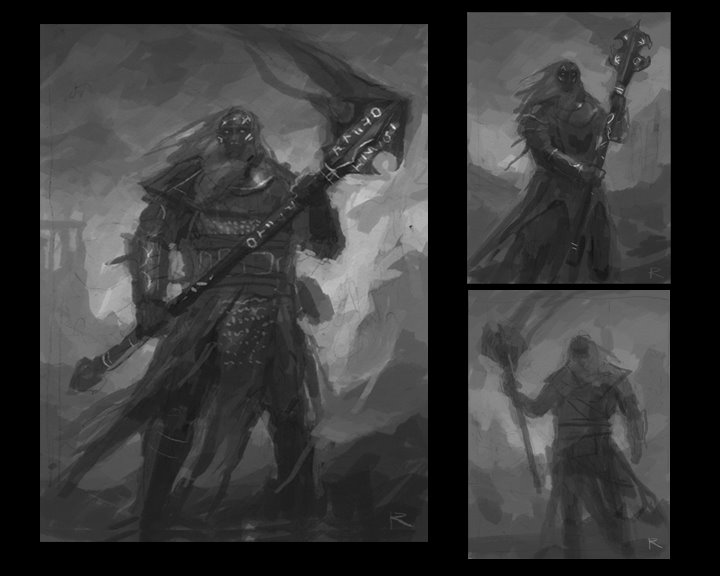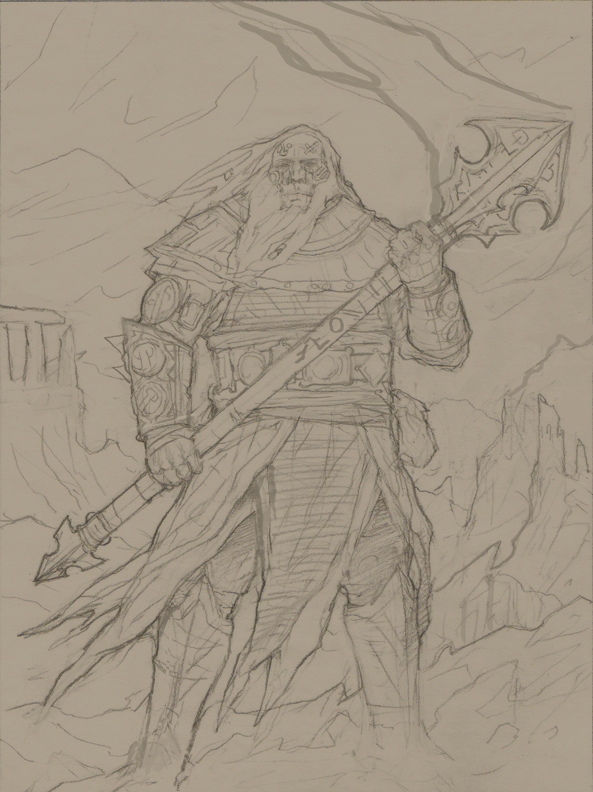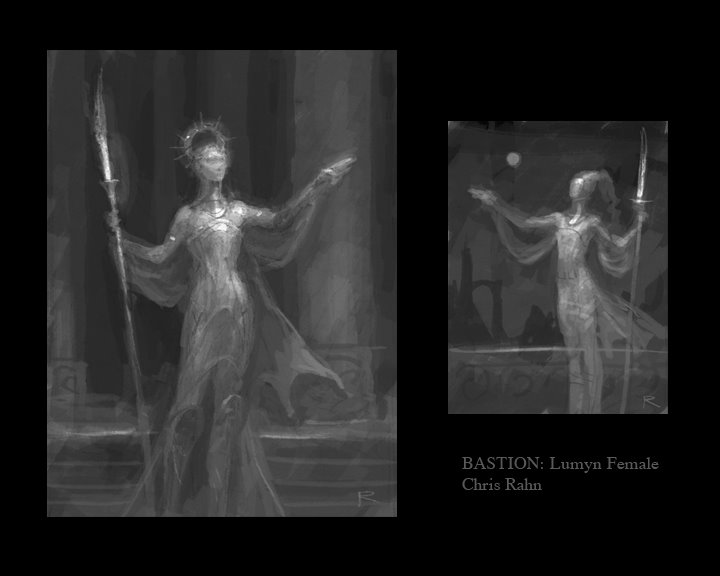With our artist selected, we needed next to think through our budget, the details and sequence of what we were commissioning, come to terms with the artist, and start the back-and-forth communication with him about what we wanted.
Of course, that makes it sound like a neatly ordered process! The reality is a bit more complicated, because we were doing many things in parallel. Justin was speaking to Chris about the scope of the project, and starting to communicate details of the Bastion world; he was also getting information about pricing on the portraits. Meanwhile, we were scrambling to decide exactly what we needed. We had not yet picked a specific deadline for a release of the game, nor did we have some external force – a conference, a meeting, etc. – driving us to have a particular packaging of the game ready by some specific time. This meant we were getting the portraits done simply because they needed to be done sometime, and because we knew we wanted whatever version or demo of the game we showed off to already look good – and because our own vision of the denizens of Bastion would sharpen for being able to see examples of each. (What we perhaps did not anticipate is how much we would learn simply from being pushed to describe these people, and their capabilities and environs, in detail.)
In our portraits, we knew we needed to show off a lot of different things at once. These portraits needed to serve as exemplars, conveying identities and qualities, whether used as illustrations or userpics. We knew we wanted to show all of the following:
- Each of the five playable races of Bastion
- Both genders
- Each of the five known magical Traditions practicable by the characters
- Common archetypes fantasy players might choose to portray
- Common skills
- Common situations
But if you try to show every combination possible of the above, you end up with a combinatoric monster that quickly eats whatever art budget you happen to throw at it (and you need to recruit an army or artists to boot). So we decided to see what we could accomplish in ten portraits. Ten gave us each possible combination of race and gender. We then decided that every Tradition would be represented.
At this point, Justin sent Chris a huge email with the lowdown on all sorts of things about the Bastion setting: background for the world, descriptions of each race, details of the Traditions, and so on. Then he described what we wanted out of the portraits. Chris liked the email, but asked that we give him more specific descriptions of how different elements should be paired up in the portraits; he was afraid that if it were left to him, he would mess up, forgetting to represent something somewhere.
So we went back, and started thinking through how to fit all these elements together. Here, we did a lot of “overloading”, to borrow a computer science term. This is a way of saying that we packed many meanings, many interpretations, into each portrait description. A Mezoar looks out over a ruined expanse, holding his spear: does he represent a warrior? An explorer? The idea of scouting? A Lumyn calls and beckons to companions in the background. Is she a leader, rallying the troops? A Dreamsinger? A mix of detail and ambiguity would be our friend here, allowing a small number of portraits to be used in many ways, and giving users a better chance to find a portrait that fit their ideas of a character. We typed up ten descriptions that were our best effort to create this brew.
Lastly, Justin talked with Chris about the scope of each portrait. He could invest different levels of effort, and put more or less effort, into each portrait, depending on how much we wanted to budget for them. Chris sent some samples of the kind of work he could do for our target $ amount; this helped a lot, and we quickly agreed on our price point. He also noted that the poses would probably not vary much from character to character, less for budgetary reasons than because of how we intended to use the portraits: Then we picked two portraits to get started – a male Forgeborn warrior, and a female Lumyn Dreamsinger – and Chris got to work.
He was fast. Really fast! The first sketches appeared in days. Now, bear in mind at this point that we had no idea how the artistic process would actually work. Would we get lots of questions? Would a painting just appear one day, crafted from whole cloth? So I didn’t know exactly what I would find when I opened that first email (this was the point where Justin handed off artistic communication duties to me). What we saw was the image from part 1: 
Three different sketches, exploring different poses and composition.
Chris also sent some ideas and questions for the Forgeborn. Could we put him in a volcanic and ruined setting? What sort of build should he have? Did it matter what his weapon looked like? Was he right to interpret the “skin like smoldering coals” as primarily dark, but with some grey and red elements?
I took the sketches back to Derek and Justin for their feedback, along with Chris’s message. This is where we benefit a lot from being a team of liberal arts majors: nobody feels unable to say valuable things about art! Everybody was really excited; there was something validating for us in seeing that our project now had quality art associated with it, albeit in sketch form. And we all agreed that Chris had really hit the nail on the head. I assembled and collated everybody’s feedback; here’s the text of the critical feedback I gave Chris:
- Everybody is very excited about what you have produced. We all agree that you’ve managed to evoke the essence of the forgeborn here. As a result, most of our feedback is on the nitpick level.
- Everybody loves the weapon, and the way the runes appear on it is spot-on. The solidity of the weapon matches well with the body and pose of the character.
- The simple perspective, and a posture that reveals almost all of the face, both work well for enabling crops of the sketch for special purposes, particularly close-ups of the face that would work well for identifying a character in a chat or a turn summary.
- Are we correct that what we see atop the character’s head is hair, and not flame or smoke?
- There is room for the forgeborn to be even a little broader than this, though not much. The risk is them verging into classic fantasy dwarf territory, which is not what we want; however, the sense of granite-like sturdiness and power that you created is great, and could perhaps go even a bit further.
- Are the runes a part of the character’s skin, or floating above it? We would prefer the former, and to keep runes off the center of the character’s forehead, so as to avoid any confusion with the rendering of a True Sight practitioner (who will manifest a sort of third-eye glow in that spot). The runes themselves are great: simple and angular is good.
- On a related note, such runes are associated specifically with runecasting (the character’s magical ability), and not with the forgeborn per se. As such, there will be forgeborn without them, and other races who show them as well. However, there is no reason the runes on a forgeborn can’t manifest a bit differently from those on other races. For example, they might glow a lava-red, in keeping with the skin being like smouldering coals. They might even feel carved into the forgeborn’s skin, where they look more like paint or tattoos on another race.
- There’s an object that might be a pouch on the side of the character. A pouch would be great; runecasters probably have a belt pouch where they keep physical runes.
- You mentioned ruins as part of the background, and I would love to see that, as the environs of Bastion should include plenty of these. What you have right now looks like classic Greek- or Roman-style columns; that could work, but perhaps they could be taken a less-marbly, and more rough-hewn and natural direction, somewhere between the Parthenon and Stonehenge (for lack of a better descriptor). The idea would be to have an ancestral forgeborn ruin, in keeping with the volcanic environs.
You can see from this a number of questions that were on our minds that were very particular to creating art for a game. We had to make sure our characters stood out from traditional depictions of fantasy races like dwarves and elves. We had to focus on visual elements that tied together with in-game equipment, like the rune pouch. We needed to do a lot to define the look of magic in our game, and to depict different kinds of magic so that each was immediately recognizable and distinct. And we had to achieve that mix of familiar and exotic that allows players to feel they are in a fantasy world, but still something they can recognize and interact with – even down to the architecture.
Chris responded to our feedback, asked for a bit more information about the skin of the Forgeborn, then proceeded to create the drawing you saw at the beginning of this post.
In the third and final post in this series, we’ll look at the female Lumyn, and how both she and the Forgeborn made it to painted form. Here’s a sneak peek at the Lumyn sketches:



Thanks for the fascinating insight into the art process for Bastion. I am really enjoying these posts!